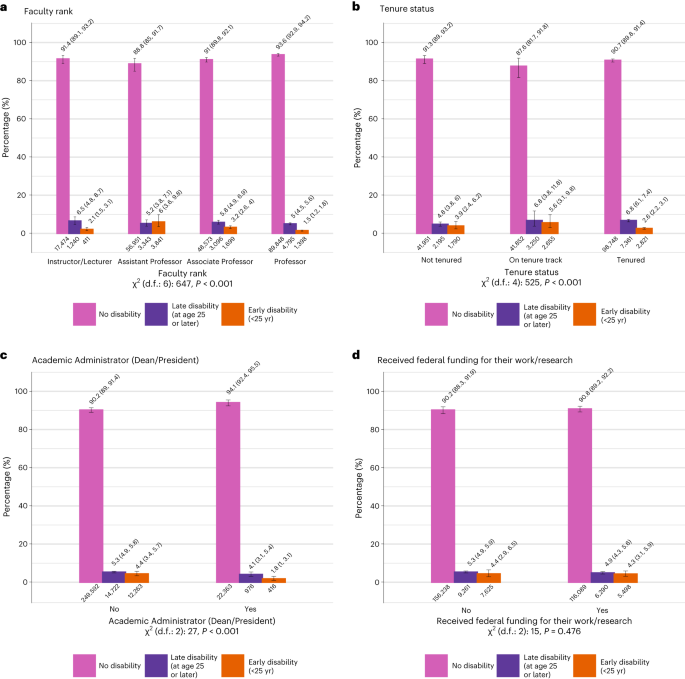Varadaraj, V., Deal, JA, Campanile, J., Reed, NS & Swenor, BK Prevalence of disabilities and types of disabilities among US adults, 2019. JAMA Netw. Open https://doi.org/10.1001/jamanetworkopen.2021.30358 (2021).
Women, Minorities, and Disabilities in Science and Engineering (National Science Foundation, 2021); https://ncses.nsf.gov/pubs/nsf21321
Swenor, BK, Munoz, B. & Meeks, LM. A decade of decline: Funding for researchers with disabilities 2008-2018. PLoS ONE https://doi.org/10.1371/journal.pone.0228686 (2020).
Bernard, M.A. Advancing Inclusion of People with Disabilities in the Scientific Workforce. NIH Blog https://diversity.nih.gov/blog/2021-07-21-advancing-disability-inclusion-scientific-workforce (2021).
Cech, E. A. “Intersectional privilege of white able-bodied heterosexual men in STEM fields.” Sci. Adv. 8, 24 (2022).
Freund, K. M. et al., “Gender inequality in academic compensation: Follow-up to the National Faculty Survey Cohort Study.” Acad. Med. https://doi.org/10.1097/ACM.0000000000001250 (2016).
2019 Survey of Doctoral Degree Recipients (National Science Foundation, 2021) https://ncses.nsf.gov/pubs/nsf21320
Berghs, M., Atkin, K., Graham, H., Hatton, C. and Thomas, C., “The impact of models and theories of disability on public health research: a scoping study and evidence synthesis,” Chapter 3 (Public Health Research Issue 4.8, NIHR Journals Library, 2016).
Dutta, A. et al., “Social cognitive career theory predictors of STEM career interest and goal persistence among minority college students with disabilities: A path analysis.” J. Vocat. Rehabil. 43, 159–167 (2015).
2020 Survey of Doctoral Degree Recipients: Average Age and Distribution of Doctoral Degree Recipients by Field of Study, Gender, Citizenship Status, Ethnicity, and Race (National Science Foundation, 2021), https://ncses.nsf.gov/pubs/nsf22300/data-tables
Austin, P. C. An introduction to propensity score methods to reduce the effects of confounding in observational studies. Multivar. Behav. Res. 46, 399–424 (2011).
Mann, DR & Wittenburg, DC. “Catching up: Wage and employment gaps between youth with and without disabilities.” J. Disabil. Policy Stud. 26, 89–99 (2015).
Campanile, J. et al., “Accessibility and Disability Inclusion at the Top-Endowed Undergraduate Institutions in the United States,” PLoS ONE https://doi.org/10.1371/journal.pone.0277249 (2022).
Goodman, N.M., Morris, Z., Morris, M., McGarrity, S. The Extra Costs of Living with Disabilities in the United States – Resetting the Policy Table (NDI, 2020). https://www.nationaldisabilityinstitute.org/reports/extra-costs-living-with-disability/
Hawley, C.E. et al., “Transitioning from college to STEM careers: The experiences of recent graduates at the intersection of ethnic minority status and disability.” Rehabil. Res. Policy Educ. 28, 183–199 (2014).
Manyibe, E. O. et al., “Career Development Factors of Minority Disability and Health Research Leaders: A Key Informant Survey,” Rehabil. Res. Policy Educ. 31, 208–229 (2017).
Lee, A. Comparing science, technology, engineering, and mathematics (STEM) enrollment in higher education between students with and without disabilities. Career Development, Transit, Exceptions, and Individuals. 34, 72-82 (2011).
Google Academic
Dali, K. The right to be included: Ensuring inclusive learning and working environments for people with disabilities in academia. Inf. Learn. Sci. https://doi.org/10.1108/ILS-04-2018-0032 (2018).
Peterson, S. & Saia, T. Disability, intersectionality, and the doctoral student experience. Rehabil. Couns. Educ. J. https://doi.org/10.52017/001c.31773 (2022).
Rao, S. & Gartin, B. C. Faculty attitudes toward accommodating students with disabilities. J. Vocat. Spec. Needs Educ. 25, 47–54 (2003).
Google Academic
Goodwin, M.E. Making the Invisible Visible: Discussing Invisible Disabilities, in HAPS Educators Special Conference, eds., pp. 62-73 (ERIC, 2020).
Macfarlane, K. A. Undocumented disability. Fordham Law Rev. https://doi.org/10.2139/ssrn.3781221 (2021).
Balcazar, F. E. et al., “Improving Transition Outcomes for Low-Income Minority Youth with Disabilities,” Exceptionality 20, 114–132 (2012).
da Silva Cardoso, E. et al. Social-cognitive predictors of STEM career interest and goal persistence among racial and ethnic minority college students with disabilities. Rehabil. Res. Policy Educ. 27, 271–284 (2013).
National Science Foundation’s Programs for People with Disabilities (National Science Foundation, 2002) https://www.nsf.gov/pubs/2002/nsf02094/nsf02094.pdf
Davis, N. A. “Invisible Disabilities,” Ethics 116, 153-213 (2005).
Hagerman, TK & Houtrow, AJ. “Variation in prevalence estimates of children’s disabilities in the National Survey of Children’s Health.” JAMA Pediatr. 175, 307–310 (2021).
van Bastelaer, A., Lemaître, G. and Marianna, P. Defining part-time work for international comparisons OECD Labour Market and Social Policy Occas. Pap. No. 22 (OECD Publishing, 1997).
Hasanah, U. Critical definitions of STEM education: A literature review. Interdiscip. J. Environ. Sci. Educ. https://doi.org/10.29333/ijese/8336 (2020).
McCaffrey, DF et al. A tutorial on multitreatment propensity score estimation using generalized boosted models. Stat. Med. 32, 3388–3414 (2013).
Funk, MJ et al. Doubly robust estimation of causal effects Am. J. Epidemiol. 173, 761–767 (2011).
DuGoff, EH, Schuler, M. & Stuart, EA. Generalizing observational study results: Applying propensity scores to complex surveys. Health Serv. Res. 49, 284–303 (2014).
Age and Sex Composition of the United States: 2010 (U.S. Census Bureau, 2010), https://www.census.gov/data/tables/2010/demo/age-and-sex/2010-age-sex-composition.html

